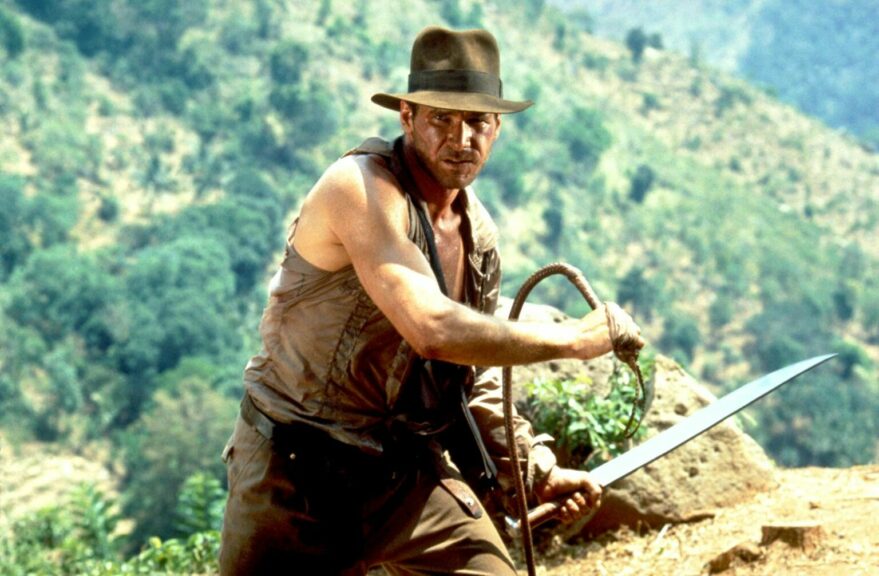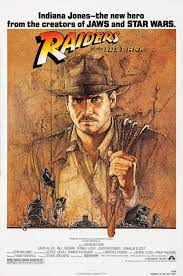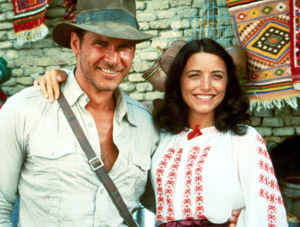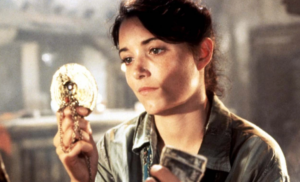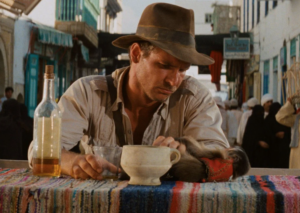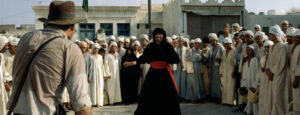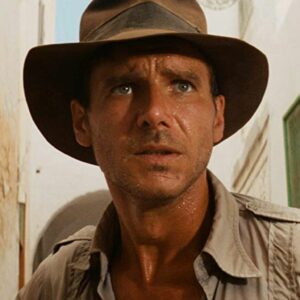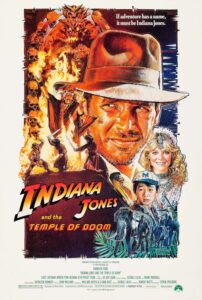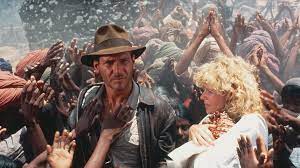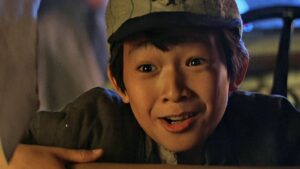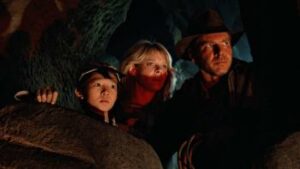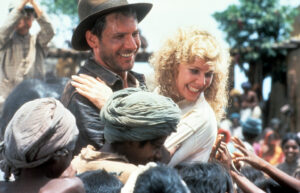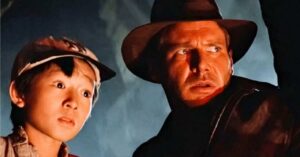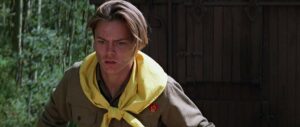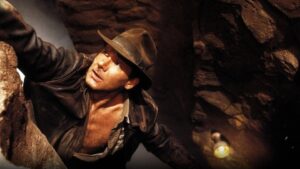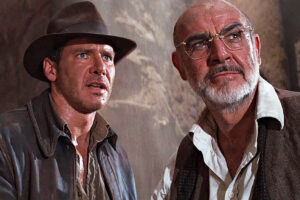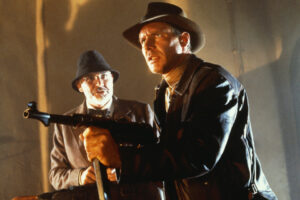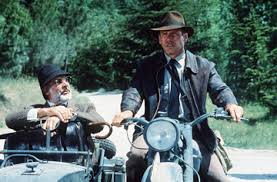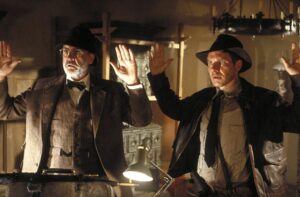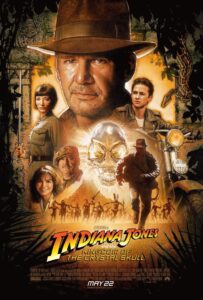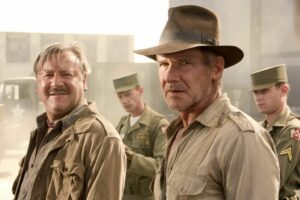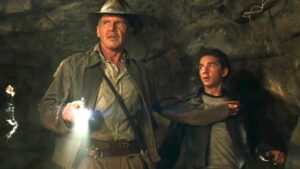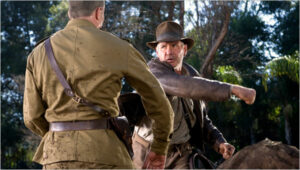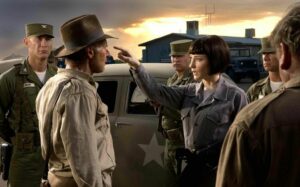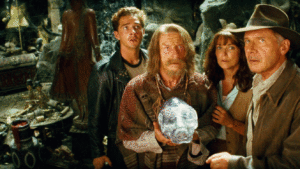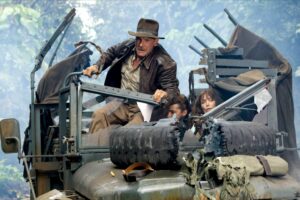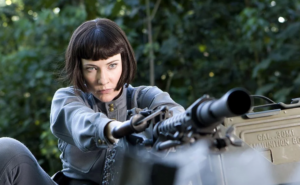The final (?) Indiana Jones adventure is just about to open (on Friday, June 30th), so now seems a perfect time to rewatch the four previous entries in the franchise. My feeling about them from previous viewings is a case of diminishing returns, and I say that knowing a lot of people love the third one unreservedly. I beg to differ. All of these movies can be found now on Disney +.
Raiders Of The Lost Ark (1981) | Directed by Steven Spielberg | Written by Lawrence Kasdan, George Lucas, and Philip Kaufman | 115 min | ▲▲▲▲▲
It’s hard to find new things to say about a picture as beloved as this one. I’m just gonna start by saying Raiders‘ reputation as slam-bang action entertainment, along with a well-crafted piece of cinema, is entirely deserved. This is the kind of film that impresses the average popcorn-loving audience and snooty cinephiles alike. Spielberg fires on all cylinders here, from the way he moves his camera (with legendary British DP Douglas Slocombe), the editing, and the absolutely essential use of John Williams’ score to enhance the dramatic moments.
And let’s not ignore the perfect casting: though I know others were considered — and can you imagine Tom Selleck in this role? — Harrison Ford is, to utilize an overused word, iconic as Indiana Jones — archeologist, bookish professor, and dashing, fearless, curmudgeonly adventurer.
I stumbled upon this delightful assessment, which if you haven’t seen it is likely to improve your impression of the film, if that’s possible:
There’s also no doubt some of this has aged poorly, starting with the whole concept of the white, western tomb raider — some might call him a grave-robber, and do in Crystal Skull — his mission to liberate cultural antiquities in order to be displayed in some Western museum, those values went out with the whole Eastern exoticism thing. Further to this movie, its depiction of the Arabs and Nepalese, and the occasional brown-face in the casting, none of that looks too good. Just as bad is the suggestion that Indy had an affair with Marion Ravenwood (the amazing Karen Allen) when she was underage.
But the rest of it is unimpeachable. It’s 1936 and Jones is chasing after The Ark of the Covenant, a box said to contain pieces of the 10 Commandments, which was considered by the ancient Jews to be a formidable weapon. Also after it are Nazis, who’ve employed one of Jones’ more successful competitors in archeology and adventuring, Frenchman René Belloq (Paul Freeman, having a blast). Once Jones finds Marion, whose father was a mentor and a man just like him, she shares a key artifact that will help him find the Ark, which is buried under the desert sands in an ancient Egyptian city called Tanis.
All this plotting could’ve been confusing, but Spielberg and his screenwriters do a terrific job outlining the stakes — at no time do we ever have any doubt as to why everybody wants this thing and what makes it so important.
The film is spotted with terrific, small performances: Denholm Elliott as Jones’ colleague, Marcus Brody, Alfred Molina as his duplicitous pal, Satipo, John Rhys-Davies as the ever-loyal Sallah, prone to raising his voice in song, Ronald Lacey as the sadistic, giggling SS man, Toht, and the always welcome William Hootkins as a military intelligence stooge, with his insistence that “top men” are on the case. (Hootkins had a long career filling supporting roles in great movies, showing up in pictures from Star Wars to Batman to Hear My Song.)
That opening in “South America” is an all-timer for setting up the kind of thrills this film offers in spades — an intoxicating mix of genuinely creepy stuff, light humour, and gritty action unencumbered by too much in the way of special effects until the finale, which is genuinely terrifying after more than 40 years. From about the halfway point the pacing never really slows, but it also never feels too hurried. (Why the Nazi submarine never submerged when Indy rode its conning tower remains a mystery, but by that point I was willing to extend the picture a whole lot of rope.)
For Jones himself, he goes from being a sceptic to being a believer in the invisible threads of the universe. He learns to respect mystical power and disrespect bureaucracy, which can’t help but resonate with audiences.
Indiana Jones and the Temple of Doom (1984) | Directed by Steven Spielberg | Written by Willard Huyck, Gloria Katz, and George Lucas | 118 min | ▲▲▲▲△
I may have seen this in cinemas, I don’t quite remember, but people who did must’ve been entirely confused by that opening dance number under credits in the Blade Runner font. What movie did we walk into? It’s a little Busby Berkeley-style magic realism to usher us into a Shanghai nightclub in 1935, with singer Willie Scott (Kate Capshaw) singing “Anything Goes” in Mandarin before Indy strolls in wearing a white tux to make a deal with a gangster, Lao Che (Roy Chiao). It’s a humdinger of an intro, no doubt.
And, yes, this is a prequel, which doesn’t make a lot of sense from a character perspective: In Raiders, Indy is entirely skeptical of “magical mumbo-jumbo,” but here he’s almost consumed by it, and by the end he “understands the power” of the mystic. He must’ve forgotten all that by the time he goes on the hunt for the Ark.
Indy and Miss Scott get out of that sticky Shanghai situation thanks to a well-timed rescue by Indy’s kid sidekick, Short Round (recent Oscar-winner, Ke Huy Quan).
When I was a kid myself I was deeply suspicious of children helping the adult heroes — I was no fan of Robin, for instance — but in retrospect, Shorty is pretty great. He’s practically Indy’s conscience here, helping him again and again. Willie, by her own admission, is a little hard to take, and she and Ford have next to no chemistry. Capshaw was quoted as saying she screams too much in the picture. I have to agree with her on that.
A brief plane ride (and crash), and Willie, Short Round, and Jones end up in rural India, where they hear the story of children stolen from a village along with a magical stone, taken to a palace of ancient evil. Naturally they find their way to said palace where they uncover a cult performing human sacrifices led by the evil Mola Ram, who can turn his followers into zombies and pull men’s hearts out of their chests.
Sounds grim, doesn’t it? The criticism of the film as too dark is fair — we get scenes of torture and violence toward children that are a little hard to watch. It’s worth remembering a whole new rating system was invented for American exhibitors because of this film, PG-13. The second act also drags more than a little and could’ve been edited down a whole lot.
In some respects the movie feels a little like the product of a cocaine-fuelled creative process. I appreciate that Spielberg and his collaborators weren’t afraid to go to these places, but that scene of the meal of snakes, beetles, and monkey brains? And voodoo dolls? Really? He’s just throwing ideas at the cockroach-covered wall to see what sticks.
And that’s just one part of a movie with a whole lot of cultural insensitivity — I wonder if Indians watching this would be more perturbed by being depicted as superstitious villagers or maniacal cultists? Add to that Indiana Jones And The White Saviour Complex, with a scene of Indians under colonial rule saving the day? It’s all a little hard to swallow as seen almost 40 years later.
But there’s also so much to enjoy in Temple Of Doom, from that amazing opening sequence, the convincing mood of creepiness throughout, to the vertiginous mine-cart ride followed by the heart-pounding finale on the rope bridge. This is a deeply flawed film, and not as good as I remember it, but the relentless, chaotic energy of the thing also makes it weirdly and wonderfully entertaining. It’s maybe the least predictable of the entire series.
Funnily, I was reminded of Ford as Han Solo more than once — like when Indy yells, “We got company!” in the mine cart. His Dr Jones definitely overlaps with his space pirate.
Indiana Jones and the Last Crusade (1989) | Directed by Steven Spielberg | Written by Jeffrey Boam, George Lucas and Menno Meyjes | 127 min | ▲▲▲△△
If the Temple of Doom wasn’t quite the film I remembered it was, The Last Crusade is a measure better than I thought, though nowhere near as bizarre as its predecessor.
This one’s set in 1939, but first we’re flashing back: The opening has Indiana Jones as a teenager, played by the amazing, still deeply missed, River Phoenix. This is the magic of movies — he will never get old, unlike the rest of us.
The opening 10-or-so minutes gives Spielberg a chance to play at being John Ford and ride horses through the desert, stage a chase along the top of a train and provide the origin of all sorts of Indiana Jones character details. Phoenix does a marvellous job of capturing Harrison Ford’s idiosyncrasies.
Then we’re on a storm-tossed trawler at sea, with adult Indy chasing the same item he was looking for as a teenager, and finally getting it. The film sets up a sense of professional closure for Jones that maybe we haven’t seen before.
After that he’s back at the college, like in the first film, and Marcus Brody’s got another message for him. Walter Donovan (frequent ’80s and Game Of Thrones heavy, Julian Glover) is a collector looking for the Holy Grail, and had employed Indy’s father (Sean Connery!), the world’s preeminent grail expert, to find it, and now he’s disappeared.
So off Junior Jones goes to Venice, with Brody along for the ride this time, to meet up with a Dr Elsa Schneider (Alison Doody), who might give Indy a clue to where his father has gone. The mystery plot here is a lot more confusing than in the two previous films, but the action comes thick and fast so we don’t have too much time to worry about it.
One of the things about Raiders that I thought worked so well is that Jones was this single, driving force against insurmountable odds but somehow finding a way to succeed, even while being captured and beaten up and not getting the artifact in the end — almost like the lead in a hard-boiled detective story. The other characters were just trying to hang on and keep up with his innate, grumpy obsession.
But in this one, with the bumbling Markus Brody, the older Dr Jones, and the return of Sallah, Indy has a crowd of friends and family around him, and it tips the action frequently into the comical. Maybe too comical — the silly scene where Indy goes to Berlin and crosses paths with Hitler, that should’ve been left on the cutting room floor, and the effects when the elder Dr Jones improvises a way to down an enemy plane on a beach, that looked pretty lame even in 1989.
But the play-by-play between Ford and Connery is terrific — naturally the man who played James Bond should be Indiana Jones’ father. The scenes in Venice are a treat and the fight on (and inside) the tank later on is pretty damn impressive. It’s also a treat to see Alexei Sayle show up in a one-scene cameo.
As a kid I thought the fact the producers chose to use the exteriors at Petra for the finale was a little annoying. Anyone who knows anything about the ancient world can identify the Jordanian tourist attraction, but Spielberg is pretending it’s some hidden Crusader city or something. It’s like shooting at the Acropolis and saying it’s Mount Olympus.
Also, pursuing the Holy Grail made me think of Monty Python — I couldn’t help it, and that association I’ve never been able to shake.
Indiana Jones and the Kingdom of the Crystal Skull (2008) | Directed by Steven Spielberg | Written by David Koepp, George Lucas, and Jeff Nathanson | 122 min | ▲▲△△△
On May 22, 2008, the fourth Indiana Jones movie was released. It took the filmmakers 19 years to settle on a script that Spielberg, Lucas, and Ford liked. Ford, who was 46 on Crusade, is 65 here. I have to admire the effort they put in to make another one of these.
It starts promisingly. The opening segment, taking place in 1957 Nevada is great — kids in hot rods listening to Elvis leading us to Area 51. Jones looks a bit more rumpled than usual but it is a blast seeing him again. The warehouse sequence is amazing, and Jones in big trouble yet again and finding his way out of it despite incredible odds (and an atom bomb test). Ford is still spry and fit, though maybe without the wit of the earlier films. You have the sense that Spielberg, with his old cronies John Williams and George Lucas, is really enjoying himself here.
Then we get into the meat of the plot. Mutt Williams (Shia LeBoeuf), seeks Jones out at the college where he now has tenure. Williams is carrying a riddle in the form of Mayan writings, written by Ox Oxley (John Hurt), an archeologist friend captured by the evil Russians (led by a hissible Cate Blanchett), which might lead him to the location of the Crystal Skull, an artifact with supposedly magical powers somehow connected to El Dorado, the legendary city of gold in the Amazon jungle. An impressive motorcycle chase takes place during this section and a fun fight scene in a 1950s diner.
Williams and Jones travel together to find Ox and Williams’ mother (no prizes for figuring out who she is, and therefore, who Mutt is) and locate the skull and the lost city. And here’s where, in what is the start of the second act, it begins to fall apart. Our heroes make an effort to find the cell where Ox is imprisoned and he’s kindly left a map there where the next stop on the tour is located, but unlike maybe some of the earlier films where they would have explained how they got to a graveyard, or even who the antagonists in the graveyard are, here we’re just expected to take all those details on faith. This just feels sloppy.
Then we’re in the Amazon, Mutt and Indy and Ox are reunited, and there are a couple of other surprises. But at this point, I started to feel as though this could pretty much be any adventure film… the special quality of the Indiana Jones movies started to wear thin.
We get a wildly goofy car chase through badly digitized jungle, a ridiculous monkeys-and-vine swinging scene, which must have been Spielberg’s effort to pay homage to Tarzan or something. The bad critters in this movie are giant ants… shoddy CGI, but pretty creepy nonetheless.
Maybe the lowest of low points is an absolutely awful scene involving an amphibious car, with everyone going over Igazu Falls, which, by the way, is on the border of Argentina and nowhere near the Amazon. That’s just being nit-picky, I know, just like that Petra thing, but it’s annoying even beyond the ridiculousness of the scenario.
My point is that by the third act, the film has turned into a cartoon. It would be great if a small measure of internal logic could be sustained, but this stuff goes way too far to suspend disbelief. I could accept the finale inspired by the Tintin comic Flight 714 and even the possibility of extraterrestrials, but the jungle waterfall sequence is so dumb it spoils a lot that goes before and after. A CGI-fest in the very end is just the worst.
Cate Blanchett is fine as the villain of the piece, but gritty character actor Ray Winstone is wasted. He spends all his time explaining why he’s a bad guy or a good guy and we don’t care. Shia LeBeouf has a certain physicality, but he’s nowhere near as charismatic he needs to be. Spielberg had spoken about more films with LeBeouf getting into Dr. Jones’ shoes as the archeologist and adventurer. For a host of reasons that feels unlikely now — Mutt Williams and the Search for Atlantis is not a movie likely to get made.
For that awesome first 30-or-so minutes, the filmmakers recaptured the spirit of the franchise. It’s a shame they aren’t able to sustain it through the middle and much of the end, even when Indy evokes Solo again with “I’ve got a bad feeling about this.” Me, too.





